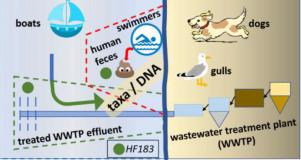Water Research ( IF 12.8 ) Pub Date : 2022-06-19 , DOI: 10.1016/j.watres.2022.118781 Dong Li 1 , Laurie C Van De Werfhorst 1 , Brandon Steets 2 , Jared Ervin 2 , Jill L S Murray 3 , Jen Smith 4 , Patricia A Holden 1

|
Fecal sources to recreational surf zone waters should be identified to protect public health. While watershed origins of human and other fecal sources are often discoverable by quantitative polymerase chain reaction (qPCR) of fecal markers using spatially stratified samples, similarly assessing wastewater treatment plant (WWTP) outfall and other offshore contributions to surf zones is challenged by individual marker fate and transport. Here, bacterial communities were assessed for relatedness between all hypothesized fecal sources and surf zone waters for two urban California recreational beaches, by sequencing genes encoding 16S rRNA and analyzing data using SourceTracker and FEAST. Ambient marine bacterial communities dominated the surf zone, while fecal (human, dog, or gull) or wastewater (sewage or treated WWTP effluent) bacterial communities were present at low proportions and those from recycled water were absent. Based on the relative abundances of bacterial genera specifically associated with human feces, the abundances of HF183 in bacterial community sequences, and FEAST and SourceTracker results when benchmarked to HF183, the major sources of HF183 to surf zone waters were human feces and treated WWTP effluent. While surf zone sequence proportions from human sources (feces, sewage and treated WWTP effluent) appeared uncorrelated to previously obtained qPCR HF183 results, the proportions of human fecal and potential human pathogen sequences in surf zone waters were elevated when there were more swimmers (i.e. during weekday afternoons, holidays and busy weekends, and race events), thus confirming previously-published qPCR-based conclusions that bather shedding contributed low levels of human fecal contamination. Here, bacterial community sequencing also showed evidence that treated WWTP effluent from an offshore outfall was entering the surf zone, thereby resolving a prior uncertainty. Thus, bacterial community sequencing not only confirms qPCR HF183-based human marker detections, but further allows for confirming fecal sources for which individual marker quantification results can be equivocal.
中文翻译:

通过细菌群落分析评估两个休闲海滩冲浪区水域的多种粪便来源
应确定休闲冲浪区水域的粪便来源,以保护公众健康。虽然人类和其他粪便来源的流域起源通常可以通过使用空间分层样本的粪便标记的定量聚合酶链反应 (qPCR) 来发现,但同样评估污水处理厂 (WWTP) 排放口和其他对冲浪区的海上贡献也受到个体标记命运的挑战和运输。在这里,通过对编码 16S rRNA 的基因进行测序并使用 SourceTracker 和 FEAST 分析数据,评估了加州两个城市休闲海滩的所有假设的粪便来源和冲浪区水域之间的相关性。环境海洋细菌群落在冲浪区占主导地位,而粪便(人类、狗、或海鸥)或废水(污水或处理过的 WWTP 流出物)细菌群落的比例较低,而来自循环水的细菌群落则不存在。根据与人类粪便特异性相关的细菌属的相对丰度、细菌群落序列中 HF183 的丰度以及以 HF183 为基准时的 FEAST 和 SourceTracker 结果,冲浪区水域的 HF183 的主要来源是人类粪便和处理过的 WWTP 流出物。虽然来自人类来源(粪便、污水和处理过的 WWTP 流出物)的冲浪区序列比例似乎与先前获得的 qPCR HF183 结果不相关,但当有更多游泳者(即在工作日下午、节假日和繁忙的周末,以及赛事),从而证实了先前发表的基于 qPCR 的结论,即沐浴者的排泄物导致了低水平的人类粪便污染。在这里,细菌群落测序还显示了来自近海排放口的处理过的 WWTP 流出物正在进入冲浪区的证据,从而解决了先前的不确定性。因此,细菌群落测序不仅证实了基于 qPCR HF183 的人类标记检测,而且还允许确认单个标记量化结果可能模棱两可的粪便来源。


























 京公网安备 11010802027423号
京公网安备 11010802027423号